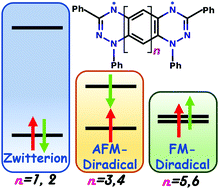Tuning the magnetic properties of a diamagnetic di-Blatter's zwitterion to antiferro- and ferromagnetically coupled diradicals†
Abstract
In the quest of obtaining organic molecular magnets based on stable diradicals, we have tuned the inherent zwitterionic ground state of tetraphenylhexaazaanthracene (TPHA), a molecule containing two Blatter's moieties, by adopting two different strategies. In the first strategy, we have increased the length of the coupler between the two radical moieties and observed a transition from the zwitterionic ground state to the diradicalized state. With a larger coupler, ferromagnetic interactions are realized based on density functional theory (DFT) and wave-function theory (WFT) based complete active space self-consistent field (CASSCF)-N-electron valence state perturbation theory (NEVPT2) methods. An analysis based on the extent of spin contamination, diradical character, CASSCF orbital occupation number, Head-Gordon's index, HOMO–LUMO and SOMOs energy gaps is demonstrated that marks the transition of the ground state in these systems. In another approach, we systematically explore the effect of push–pull substitution on the way to obtain molecules based on a TPHA skeleton with diradicaloid state and, in some cases, even a triplet ground state.



 Please wait while we load your content...
Please wait while we load your content...